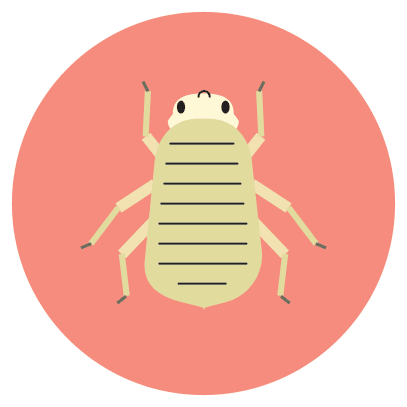TROUBLESHOOTING
APHIDS
APHIDS
WHAT TO LOOK FOR:
Of all pests, aphids are the ones most likely to appear on indoor plants. They are very small — only around 1/16” to 1/8” long — and can come in many colors, such as pale green, pink, yellow, red, white, and black. Tending to appear in clusters on the underside of leaves, and particularly on young, new, tender leaves, aphids can be winged or wingless, and can be very difficult to spot as they are tiny and often blend in very well with the plant.
Plants can withstand some aphids, but if a particularly bad infestation hits, the plant can start to suffer.
HOW IT HURTS:
Aphids eat the sap from leaves. Veggie plants can usually withstand a number of aphids without affecting the yield, but if they get out of control they can stunt and distort the plants which will affect their ability to thrive. Leaves that the aphids are feeding on can start to yellow or appear distorted, and can even start to drop off.
HOW TO HELP:
It is not recommended to use synthetic or harmful pesticides — especially inside! You don’t want those kinds of chemicals on the food you eat, or to breathe them in if you spray inside your home. Outside, pesticides (including organic ones) can harm beneficial insects such as bees, so it’s best to use sparingly — or try to find other methods.
Spray them off with water:
One of the easiest ways to eliminate aphids is to spray them off of the plant with water. This is easiest to do outside with a hose, but you could carefully attempt this in your kitchen sink if you have a strong sprayer. While a fairly strong spray will be needed to dislodge the aphids, don’t spray so strongly that it harms the plant.Use insecticidal soap:
Either buy an organic insecticidal soap, or create your own by combining 2.5 tablespoons of vegetable oil and 2.5 tablespoons of liquid dish soap (such as Dr. Bronner’s Pure-Castile Soap) with 1 gallon of distilled water. Put the soap into a clean and empty spray bottle and spray the entire plant (including both sides of the leaves!) Re-apply if your plant is outside and has been rained on.Use neem oil:
Neem oil is a naturally occurring pesticide created from the seeds of the neem tree. It can be strong smelling and would be better suited for outside applications. You may need to re-apply if your plant is outside and has been rained on.Use beneficial bugs:
If your plants are growing outside, you can introduce or purchase beneficial bugs that like to eat aphids. One such bug is the common ladybug. Just place the package of ladybugs at the base of the infested plants in the evening, ensuring that you’ve sprayed a bit of water on the plant before you open the package. The ladybugs will seek out food and water once they wake up in the morning and leave their container. If food (the aphids!) and water is not available, they’ll fly away before they have time to munch on the aphid population.

